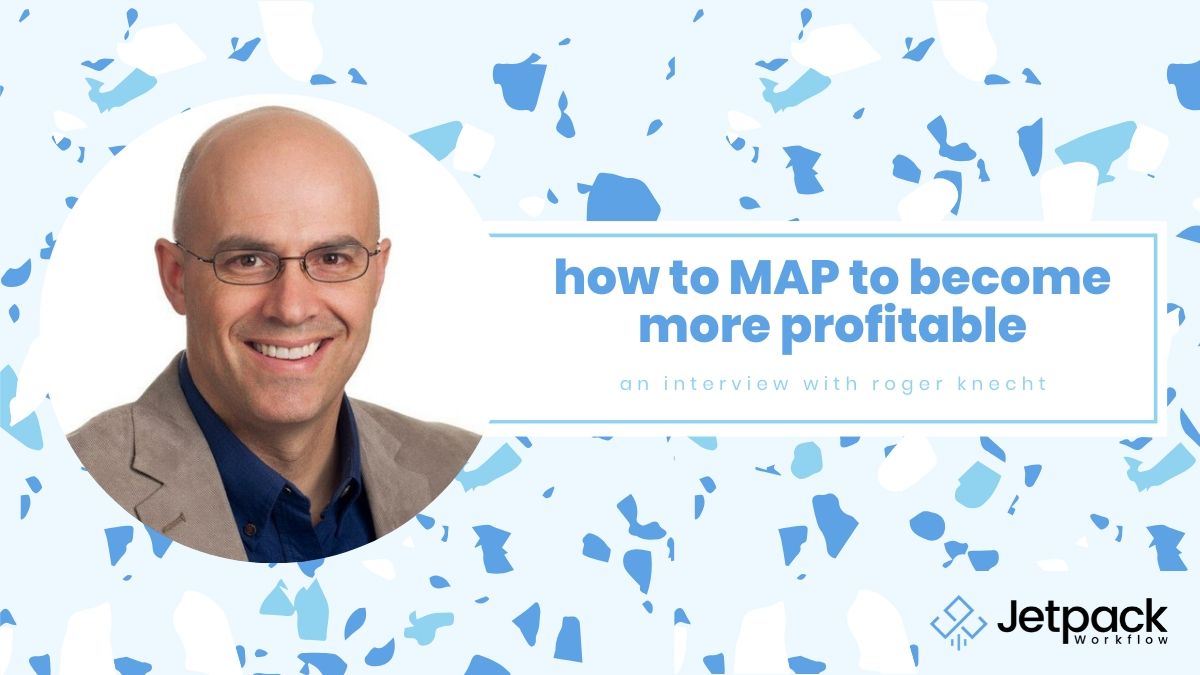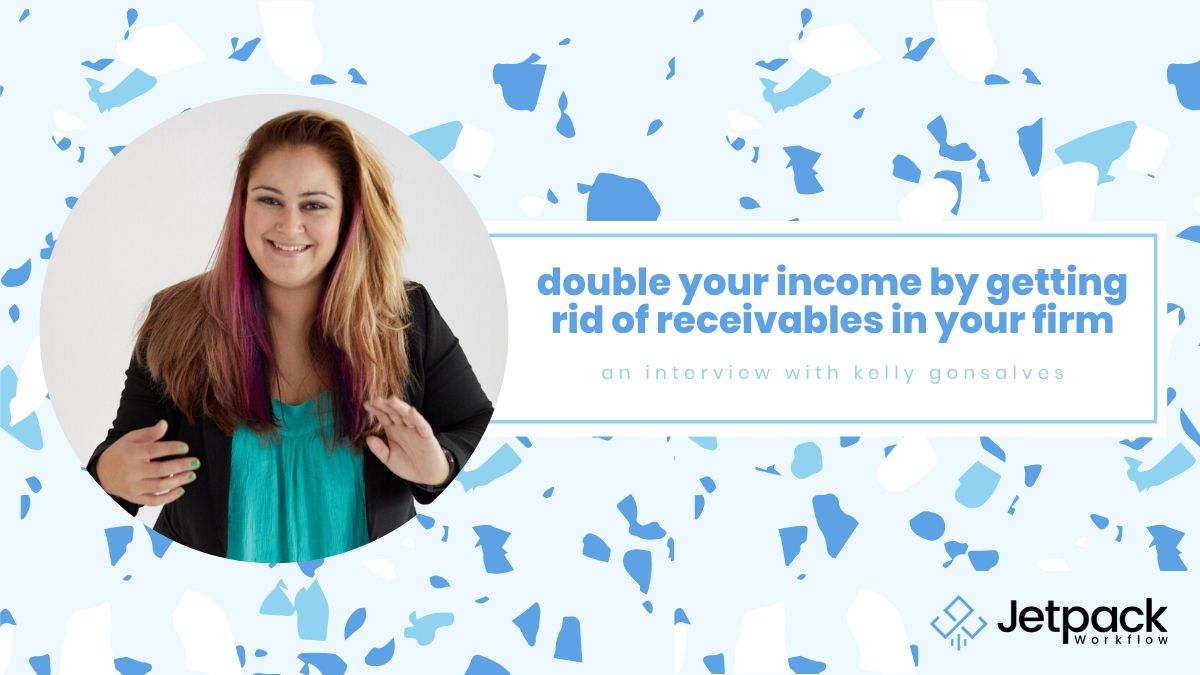How To MAP To Become More Profitable

Roger Knecht is the President of Universal Accounting, a company that helps accountants, bookkeepers, and tax preparers start and build their accounting businesses into profitable enterprises.
One of the core methods they teach is called MAP. You’re going to learn the basics of this tool and where you can learn more information about it.
In this episode of the Growing Your Firm podcast by Jetpack Workflow Software, David Cristello and Roger Knecht will discuss:
- What MAP stands for
- The basics of the MAP system
- The most important metrics for your accounting business
- Where to find more information about MAP training
ADDITIONAL LINKS:
- More About Roger Knecht
- Roger’s free eBook “In The Black”
- Training video about improving your firm’s profitability
- How to schedule a 30-minute breakthrough call with Roger
Finding Your MAP
Roger Knecht teaches people how to create their own premiere accounting firms with the MAP system. It is the system that Universal Accounting uses to shape up their clients.
MAP is an acronym for marketing, accounting, and production. These are the three core buckets of any accounting business. If you are not making as much money as you should, something is wrong in one or more of these areas. The profits really get started when all three areas are correctly tuned.
Let’s take an example firm, a small accounting business with 3-6 employees that has been doing well enough for a decade. They’re doing okay, but they’re not as profitable as they could be. How can MAP be applied?
First, it depends on the business’ goals. Here are some examples:
Marketing – Gaining more clients, improving visibility among local business owners, closing more sales
Accounting – Improving existing client relations, improving the skills of the employees
Production – Bringing in more work to better use employees, improving employee workflows, offering more services to generate more revenue, growing efficiency.
Improving Production
Let’s take a look at some ways to improve production. If you have multiple employees, each one will have their own way of doing what they do. Bookkeepers and CPAs often create their own procedures and checklists for the job and for how they interact with clients.
Some of these processes are going to be more efficient or productive than others. Part of your job as the owner is to pull out those processes, document them, and then train the rest of your employees on the best procedures you have. There are several good reasons to do this.
- If your employee were to quit, retire, or get fired, that knowledge would be lost.
Many of the owners we’ve worked with had a genuine fear that their best employee would leave. Literally, their entire IP or USP was locked up in one person. Great for the employee, but not so good for the owner.
- Most employees do want to work smarter, not harder.
If you can teach them a better way to do their job and show them why the new way is better for the clients, whether that’s a superior offering or a faster completion, they’ll embrace it.
- Owners also gain confidence that their business can offer the best services their firm can offer because everyone is using the same efficient process.
This is something Universal Accounting calls “pure bookkeeping”. In fact, Universal Accounting uses Jetpack to help their clients find these efficient processes.
- Last but not least, the business as a whole will become more efficient.
This is only the first part of improving production. Once you’ve raised your efficiency, now you need to provide that information to the client in a way that’s useful and valuable to them.
If you can do this, your clients will appreciate your product and come back to you for more. Client retention increases, as does profit.
Here’s a benchmark we like to use. According to the AICPA, the lifetime value of an accounting firm’s client is seven years. We want to meet or beat that lifetime value, but to do that your production has to be on point. Efficient processes and valuable products that allow businesses to make decisions is the name of the game.
Improving Accounting
Now let’s look at the accounting side. Every accounting firm has a core competency. It could be payroll, it could be taxes, but whatever it is, it gives them the confidence to go to clients and approach them with an offer.
Once you know your core competencies, it’s time to think about how could you make these more profitable. If you’re charging $500 a month, but you’re doing financials by hand in journals and ledgers, then it’s time to look at automation! This is where looking at accounting tools really comes in handy. Any tool that lets you improve your core competency is worth a look. If you can speed up the time it takes to do something while keeping the same price, that’s instant profit.
So, improving the accounting part of MAP is all about improving your competency at your core services so you can approach clients with the confidence that you have the superior solution. And that brings us to marketing.
Improving Marketing
Now that existing services are more efficient through workflow improvements and core competencies are identified and shored up, it’s time to look at marketing.
You might be the best tax preparer in the nation, but if you don’t have clients you don’t have a business. Many firms know how to identify their ideal clients and making them curious about their offerings. However, they lack a crucial second part of marketing: they can’t close or retain deals.
You can be getting tons of referrals and people who want your services, but if you can’t close or retain deals then that’s a serious problem. You have to onboard the client efficiently so you can get them a valuable product as soon as possible. The longer the gap between their making a decision to use your firm and getting value back from their investment, the faster they’ll leave.
There is a point in every business once you get enough clients that the challenge is no longer going out to get the next client. It’s about retaining the clients you already have and improving the value you provide so you can charge them more and get them to give more referrals.
One of the great things about all the automation we have today is that we can turn our attention away from the work to prepare the financials and do the accounting to interpreting this information for clients so they can make better business decisions. This interpretation is a value-added service, and it’s really where margins begin to explode and you can get paid what you’re worth.
When you can identify and provide these extra interpretation services, this can feed back into your marketing to help you get more lucrative clients. It’s a virtuous circle.
Where To Start?
MAP covers a lot of territories, so where do you start? There are some essential metrics to examine and questions to ask to make that decision. Marketing is first because if you have no sales you have no business. Start with these questions:
- How is the health of your sales funnel?
- How many new introductions and referrals is your firm getting each month?
- How many engagements each month?
- How many deals have you closed?
- If you have maxed out your clients, how are you going to replace your worst one?
What do we look for in production and accounting?
- What are the average billable hours for your long-term and short-term clients?
- How can you turn your short-term clients (e.g. once-a-year tax clients) into long-term clients?
- How can you lower this number while still retaining your base rate?
- What is your average revenue per client?
- How could you raise it by creating more value? More meetings, better presentations?
Where Can I Learn More?
This is just the surface of the MAP system. Universal Accounting has a book called “In The Black”, now in its 7th printing, that goes over the nine principals of the MAP system. People reading this can get a free copy of it by going to the link at the top of this post. There is also a link to a video that explains how firms should be charging for their services and how they can get more in line with the current averages that are out there in the market. Finally, if you are interested in working with Roger one-on-one, there’s a link to schedule a 30-minute breakthrough session to discuss ways to improve the profitability of your firm using MAP.
We’d like to thank Roger for his time today on Growing Your Firm by Jetpack Workflow Software and hope that our readers and listeners can use this advice to help earn more money in the coming year.
RELATED ARTICLES:






